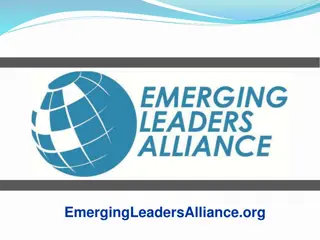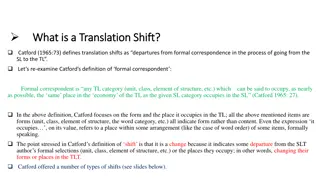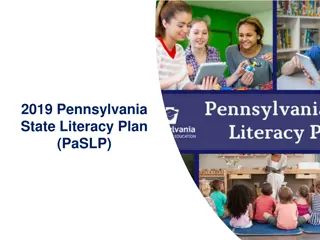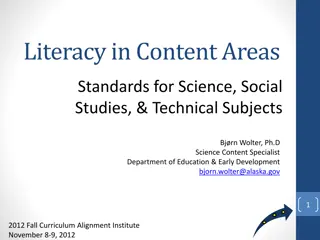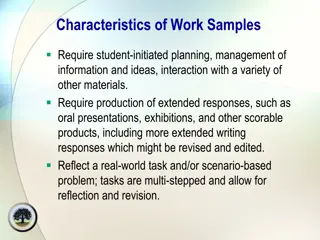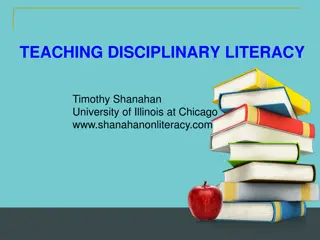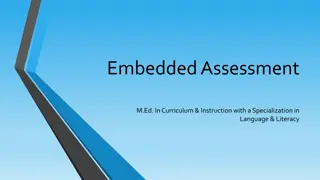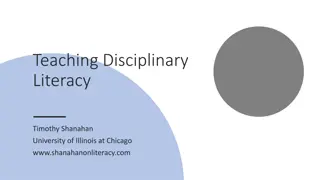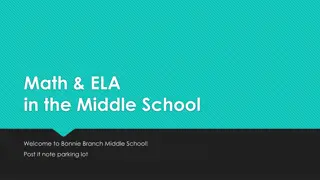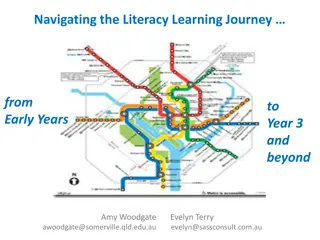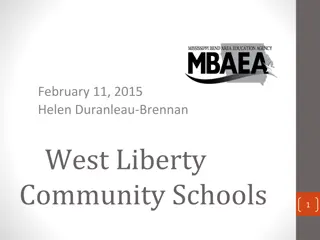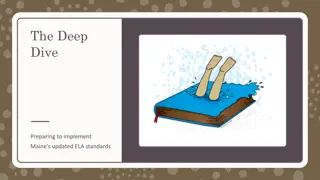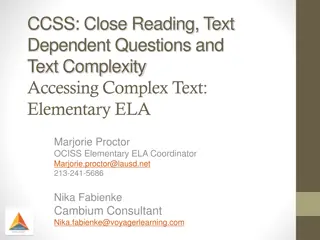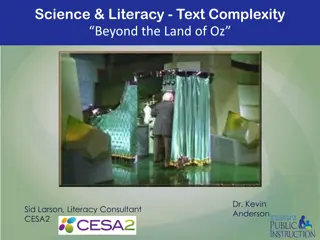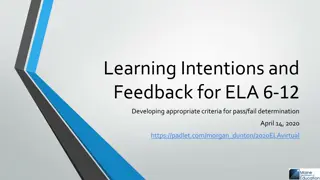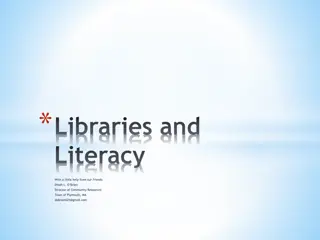Understanding Common Core State Standards ELA/Literacy Focus - Shifts and Text Complexity
The Common Core State Standards for ELA/Literacy require three key shifts, emphasizing regular practice with complex text and academic language, grounding reading, writing, and speaking in textual evidence, and building knowledge through content-rich nonfiction. The importance of practicing with complex text is highlighted due to the significant gap between high school and college reading levels, with student success in college strongly correlated to their ability to tackle complex texts. Text complexity is determined by qualitative features such as transitions, themes, vocabulary, sentence structure, and more.
Download Presentation

Please find below an Image/Link to download the presentation.
The content on the website is provided AS IS for your information and personal use only. It may not be sold, licensed, or shared on other websites without obtaining consent from the author. Download presentation by click this link. If you encounter any issues during the download, it is possible that the publisher has removed the file from their server.
E N D
Presentation Transcript
Understanding Common Core State Standards ELA/Literacy Focus 2014 Bargaining, Public Affairs and Professional Issues Conference Melanie A. Waltz, MEA Field Services Consultant mwaltz@mea.org
The CCSS Requires Three Shifts in ELA/Literacy 1. Regular practice with complex text and its academic language 2. Reading, writing and speaking grounded in evidence from the text, both literary and informational 3. Building knowledge through content-rich nonfiction achievethecore.org 2
Shift #1: Regular practice with complex text and its academic language 3 achievethecore.org 3
Regular Practice With Complex text and Its Academic Language: Why? Gap between complexity of college and high school texts is huge. What students can read, in terms of complexity, is greatest predictor of success in college ( 2006 ACT study). Too many students are reading at too low a level. Standards include a staircase of increasing text complexity from elementary through high school. Standards also focus on building general academic vocabulary so critical to comprehension. achievethecore.org 4
Determining Text Complexity achievethecore.org 5
Which text is more complex? Text 1 Text 2 Lincoln was shaken by the presidency. Back in Springfield, politics had been a sort of exhilarating game; but in the White House, politics was power, and power was responsibility. Never before had Lincoln held executive office. In public life he had always been an insignificant legislator whose votes were cast in concert with others and whose decisions in themselves had neither finality nor importance. As President he might consult with others, but innumerable grave decisions were in the end his own, and with them came a burden of responsibility terrifying in its dimensions. According to those who knew him, Lincoln was a man of many faces. In repose, he often seemed sad and gloomy. But when he began to speak, his expression changed. The dull, listless features dropped like a mask, said a Chicago newspaperman. The eyes began to sparkle, the mouth to smile, the whole countenance was wreathed in animation, so that a stranger would have said, Why, this man, so angular and solemn a moment ago, is really handsome. achievethecore.org 6
What are the Qualitative Features of Complex Text? Subtle and/or frequent transitions Multiple and/or subtle themes and purposes Density of information Unfamiliar settings, topics or events Lack of repetition, overlap or similarity in words and sentences Complex sentences Uncommon vocabulary Lack of words, sentences or paragraphs that review or pull things together for the student Longer paragraphs Any text structure which is less narrative and/or mixes structures achievethecore.org 7
Close Analytic Reading Requires prompting students with text-dependent questions to unpack complex text and gain knowledge. Text dependent questions require text-based answers evidence. Not teacher summarizing text, but guiding students through the text for information. Virtually every standard is activated during the course of every close analytic reading exemplar through the use of text dependent questions. Supports fluency achievethecore.org 8
Scaffolding Complex Text The standards require that students read appropriately complex text at each grade level independently (Standard 10). However there are many ways to scaffold student learning as they meet the standard: Multiple readings Read Aloud Chunking text (a little at a time) Provide support while reading, rather than before. achievethecore.org 9
Scaffolds for Reading Complex Text Chunking Reading and rereading Read aloud Strategic think aloud Scaffolding questions Heterogeneous small groups Recording Pre-prepping struggling readers to support confidence and participation Annotation strategies Cornell notes Paraphrasing and journaling achievethecore.org 10
Considerations for ELL/SPED Instruction must include both macro-scaffolding, in which teachers attend to the integration of language and content within and across lessons and units, as well as microscaffolding during the moment-to- moment work of teaching. 1 In order to develop the ability to read complex texts and engage in academic conversations, ELs and SPED population need access to such texts and conversations, along with support in engaging with them. With support, ELs can build such repertoires and engage productively in the kinds of language and literacy practices called for by the Standards for both ELA and other disciplines. 1 Bunch, George C., Amanda Kibler, and Susan Pimentel. "Realizing Opportunities for English Learners in the Common Core English Language Arts and Disciplinary Literacy Standards." Understanding Language, Stanford University. Web. achievethecore.org
Shift #2: Reading, Writing and Speaking Grounded in Evidence From Text, Both Literary and Informational 12 12 achievethecore.org
Reading, Writing and Speaking Grounded in Evidence from Text: Why? Most college and workplace writing requires evidence. Evidence is a major emphasis of the ELA Standards: Reading Standard 1, Writing Standard 9, Speaking and Listening standards 2, 3 and 4, all focus on the gathering, evaluating and presenting of evidence from text. Ability to cite evidence differentiates strong from weak student performance on NAEP. Being able to locate and deploy evidence are hallmarks of strong readers and writers. achievethecore.org 13
Distribution of Communicative Purpose Writing Speaking and Listening achievethecore.org 14
Content Shift #2 Text-Dependent Questions Not Text-Dependent Text-Dependent What makes Casey s experiences at bat humorous? In Casey at the Bat, Casey strikes out. Describe a time when you failed at something. In Letter from a Birmingham Jail, Dr. King discusses nonviolent protest. Discuss, in writing, a time when you wanted to fight against something that you felt was unfair. What can you infer from King s letter about the letter that he received? The Gettysburg Address mentions the year 1776. According to Lincoln s speech, why is this year significant to the events described in the speech? In The Gettysburg Address Lincoln says the nation is dedicated to the proposition that all men are created equal. Why is equality an important value to promote? achievethecore.org 15
Text-Dependent Questions are not Low-level, literal, or recall questions Focused on comprehension strategies Just questions achievethecore.org 16
Text-Dependent Questions... Can only be answered with evidence from the text. Can be literal (checking for understanding) but must also involve analysis, synthesis, evaluation. Focus on word, sentence, and paragraph, as well as larger ideas, themes, or events. Focus on difficult portions of text in order to enhance reading proficiency. Can also include prompts for writing and discussion questions. achievethecore.org 17
Three Types of Text-Dependent Questions When you're writing or reviewing a set of questions, consider the following three categories: Questions that assess themes and central ideas Questions that assess knowledge of vocabulary Questions that assess syntax and structure achievethecore.org 18
Creating Text-Dependent Questions Step One: Identify the core understandings and key ideas of the text. Step Two: Start small to build confidence. Step Three: Target vocabulary and text structure. Step Four: Tackle tough sections head-on. Step Five: Create coherent sequences of text-dependent questions. Step Six: Identify the standards that are being addressed. Step Seven: Create the culminating assessment. achievethecore.org 19
Core Understanding and Key Ideas Reverse-engineered or backwards-designed Crucial for creating an overarching set of successful questions Critical for creating an appropriate culminating assignment achievethecore.org 20
Vocabulary Which words should be taught? Essential to understanding text Likely to appear in future reading Which words should get more time and attention? More abstract words (as opposed to concrete words) persist vs. checkpoint noticed vs. accident Words which are part of semantic word family secure, securely, security, secured achievethecore.org 21
Syntax and Text Dependent Questions Syntax can predict student performance as much as vocabulary does. Questions and tasks addressing syntax are powerful. Example: Who are the members of the wolf pack? How many wolves are in the pack? To answer this, pay close attention to the use of commas and semi-colons in the last paragraph on pg. 377. The semi-colons separate or list each member in the pack. achievethecore.org 22
Structure and Text-Dependent Questions Text-dependent questions can be crafted to point students attention to features of text that enhance understanding (such as how section headers and captions lead to greater clarity or provide hints regarding what is most important in informational text, or how illustrations add to a narrative). achievethecore.org 23
Structure and Text Dependent Questions Examples: Look at the illustrations on page 31. Why did the illustrator include details like the power outlets in the walls? Dillard is careful to place opposing descriptions of the natural and man-made side-by-side. How does this juxtaposition fit with or challenge what we have already read? Why might she have chosen this point in the text for these descriptions? achievethecore.org 24
Reading Strategies and Text-Dependent Questions Text-dependent questions generally call on students to employ reading strategies. Strategies are no longer taught in isolation. The text and readers need to comprehend it should determine what strategies are activated - not the other way around. achievethecore.org 25
Final Thoughts There is no one right way to have students work with text- dependent questions. Providing for the differing needs of students means providing and scaffolding supports differentially - not asking easier questions or substituting simpler text. Listening and speaking should be built into any sequence of activities along with reading and writing. Re-read it, think it, talk it, write it The CCSS require ALL students to read and engage with grade appropriate complex text regularly. This requires new ways of working in our classrooms. achievethecore.org 26
Shift #3: Building knowledge through achievethecore.org 27
Building Knowledge Through Content-rich Nonfiction Why? Students are required to read very little informational text in elementary and middle school. Non-fiction makes up the vast majority of required reading in college/workplace. Informational text is harder for students to comprehend than narrative text. Supports students learning how to read different types of informational text. achievethecore.org 28
Distribution of Literacy and Informational Texts achievethecore.org 29
Shared Responsibility The grades 6 12 standards are divided into two sections, one for ELA and the other for history/social studies, science, and technical subjects. This division reflects the unique, time-honored place of ELA teachers in developing students literacy skills while at the same time recognizing that teachers in other areas must have a role in this development as well. from the Common Core State Standards for English Language Arts and Literacy in History/Social Studies, Science, and Technical Subjects, page 4. achievethecore.org 30
All Teachers Support Literacy This interdisciplinary approach to literacy stems from extensive research establishing the need for college and career ready students to be proficient in reading complex informational texts, independently, in a variety of content areas. Most of the required reading in college and workforce training programs is informational in structure and challenging in content Postsecondary education programs typically provide students with both a higher volume of such reading than is generally required in K 12 schools and comparatively little scaffolding. The 2009 reading framework of the National Assessment of Educational Progress (NAEP) requires a high and increasing proportion of informational text on its assessment as students advance through the grades. achievethecore.org 31
Shifts Mean a Change in Practice! From To Content knowledge primarily from teacher-led lecture Content knowledge comes from a balance of reading, writing lecture, and hands-on experience achievethecore.org 32
www.achievethecore.org achievethecore.org 33



